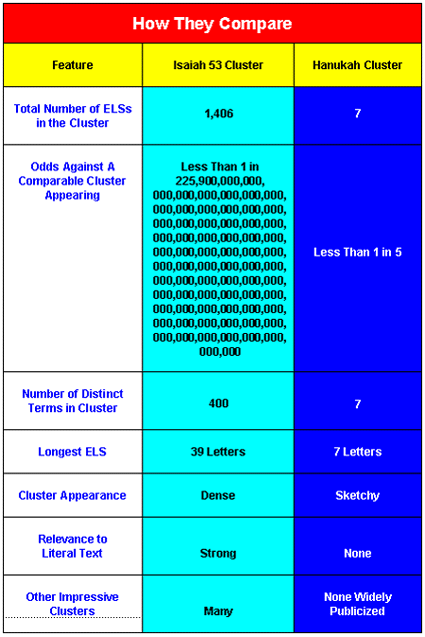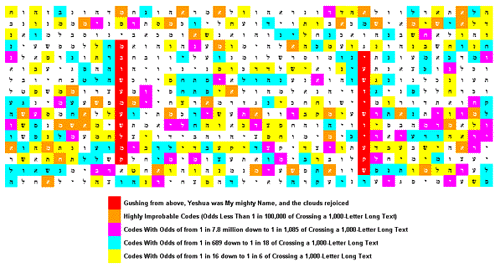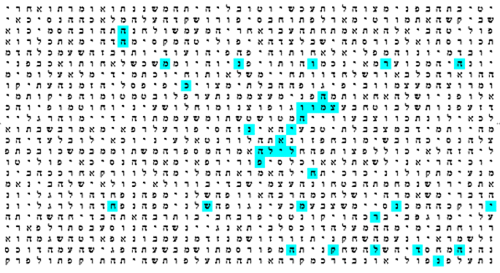HERE: http://www.biblecodedigest.com/page.php/179
New Study Underscores
Hebrew’s Challenges
Continued
The Hebrew language, arguably man’s oldest, is delightful in its directness. One interesting example is the word for blood, "dahm":

The first human being to live because of blood was Adam, pronounced in Hebrew "a-DAHM":

What was Adam made of? The dust of the ground, or earth ("dust to dust, earth to earth"), pronounced "a-dahm-AH":

Our Hebrew expert, Nathan Jacobi, has always told us that, on the other hand, Hebrew is also quite subjective when being translated. Ask 10 experts to translate a string of Hebrew letters into English, for instance, and so you will get 10 different versions of what the letters say.
This issue was driven home to us recently during one phase of our Islamic Nations Experiment. A key component of the project required "blind" attempts to extend single word ELSs of the names of Islamic nations from both War and Peace and the book of Ezekiel into longer ELSs.
Born in France before World War II, Nathan survived the holocaust. He was seven years old when his parents took him to Israel after the war, so he studied Hebrew nearly all of the way through school, during a time when Israeli schools taught biblical Hebrew as well as the "every day" language. Nathan holds a Ph.D. in Physics from Weizman Institute of Science in Rehovot, Israel, and received the M.Sc. in Physics and the B.Sc. in Mathematics from Bar-Ilan University in Ramat-Gan, Israel. He also teaches Hebrew to adult classes weekly.
Comparing Productivity
We used the results of his extensions to compare the lengthy code productivity of the two books. One surprising outcome of this experiment was the discovery of a few long codes in War and Peace. Bible code proponents, including us, had said that the longest code found in any book other than the Bible was just seven letters long. But we found codes 40 letters long from War and Peace during our research. However, not only were there no discernible clusters of codes in War and Peace.
As a test of the ambiguity of Hebrew and to double check our results, we asked another Hebrew expert to translate the same 22 ELSs that Nathan extended. Moshe Shak, a highly qualified and experienced code researcher and frequent contributor to this newsletter, agreed to take on the challenge. A mechanical engineer and now a resident of Montreal, Moshe is a Sabra, a native Israeli, so Hebrew is his native tongue. He is a graduate of Sir George Williams (now Concordia) University in Montreal.
We were expecting a difference of opinion here and there on the translations of these strings, but not the frequent differences that we saw when comparing the two expert’s translations. In some cases the differences had to do with the ways in which the letters were parsed. In others they were due to use of words of the same spelling, but with different meanings or pronunciations (homographs), like the "bow" of a ship, "bow" and arrow and "bow" and scrape. And in some cases, it was a conflict between meanings in biblical Hebrew and modern Hebrew.
Dr. Jacobi developed the rating system for Hebrew translations, or Hebrew Quality Component (HQC), which both translators applied to their translations. The ratings are based on a mix of language quality, syntax and poetic beauty. The highest is 1.0, which Nathan has used only once, for the focal code of the Isaiah 53 cluster, Gushing from Above, My Mighty Name Arose Upon Jesus, and the Clouds Rejoiced.
By the way, it should also be said that we often work with the translations we receive, trying different meanings on Nathan, especially in the case of ambiguous translations, until we have ELSs that make some sense. We did not do that in this case, because we were not that concerned with the meanings for this experiment. Moshe’s comment on the results was, "The weakest part in this research is the subjectivity of both Hebrew specialists in assigning values."
Here is the first group of ELSs with their original letter presentations, how the Hebrew experts parsed and translated them, with letter counts and quality ratings. The rest of the experiment ELSs will be in the July issue.
Our Hebrew expert, Nathan Jacobi, has always told us that, on the other hand, Hebrew is also quite subjective when being translated. Ask 10 experts to translate a string of Hebrew letters into English, for instance, and so you will get 10 different versions of what the letters say.
This issue was driven home to us recently during one phase of our Islamic Nations Experiment. A key component of the project required "blind" attempts to extend single word ELSs of the names of Islamic nations from both War and Peace and the book of Ezekiel into longer ELSs.
Born in France before World War II, Nathan survived the holocaust. He was seven years old when his parents took him to Israel after the war, so he studied Hebrew nearly all of the way through school, during a time when Israeli schools taught biblical Hebrew as well as the "every day" language. Nathan holds a Ph.D. in Physics from Weizman Institute of Science in Rehovot, Israel, and received the M.Sc. in Physics and the B.Sc. in Mathematics from Bar-Ilan University in Ramat-Gan, Israel. He also teaches Hebrew to adult classes weekly.
Comparing Productivity
We used the results of his extensions to compare the lengthy code productivity of the two books. One surprising outcome of this experiment was the discovery of a few long codes in War and Peace. Bible code proponents, including us, had said that the longest code found in any book other than the Bible was just seven letters long. But we found codes 40 letters long from War and Peace during our research. However, not only were there no discernible clusters of codes in War and Peace.
As a test of the ambiguity of Hebrew and to double check our results, we asked another Hebrew expert to translate the same 22 ELSs that Nathan extended. Moshe Shak, a highly qualified and experienced code researcher and frequent contributor to this newsletter, agreed to take on the challenge. A mechanical engineer and now a resident of Montreal, Moshe is a Sabra, a native Israeli, so Hebrew is his native tongue. He is a graduate of Sir George Williams (now Concordia) University in Montreal.
We were expecting a difference of opinion here and there on the translations of these strings, but not the frequent differences that we saw when comparing the two expert’s translations. In some cases the differences had to do with the ways in which the letters were parsed. In others they were due to use of words of the same spelling, but with different meanings or pronunciations (homographs), like the "bow" of a ship, "bow" and arrow and "bow" and scrape. And in some cases, it was a conflict between meanings in biblical Hebrew and modern Hebrew.
Dr. Jacobi developed the rating system for Hebrew translations, or Hebrew Quality Component (HQC), which both translators applied to their translations. The ratings are based on a mix of language quality, syntax and poetic beauty. The highest is 1.0, which Nathan has used only once, for the focal code of the Isaiah 53 cluster HERE: http://www.biblecodedigest.com/page.php/9 , Gushing from Above, My Mighty Name Arose Upon Jesus, and the Clouds Rejoiced.
By the way, it should also be said that we often work with the translations we receive, trying different meanings on Nathan, especially in the case of ambiguous translations, until we have ELSs that make some sense. We did not do that in this case, because we were not that concerned with the meanings for this experiment. Moshe’s comment on the results was, "The weakest part in this research is the subjectivity of both Hebrew specialists in assigning values."
Here is the first group of ELSs with their original letter presentations, how the Hebrew experts parsed and translated them, with letter counts and quality ratings. The rest of the experiment ELSs will be in the July issue.



